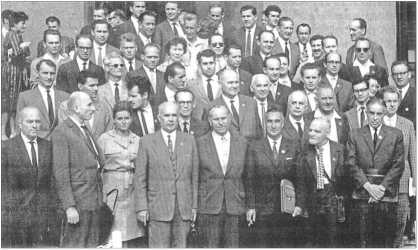869568706
Przegląd Geologiczny, vol. 55, nr 12/1, 2007

Fig. 12. Photo of Polish geologists team during the Carpathian-Balkan Association in Cracow in 1963 (from left: Stanisław Wdowiarz, Feliks Łaszczyć, Jadwiga Urbaniak, Walery Goetel, Mieczysław Mrozowski, Henryk Świdziński, Stanisław Krajewski, Marian Kamieński and others)
H. Świdziński (Fig. 9), M. Książkiewicz with his team (1956), J. Kruczek (1997,1999), P. Kamkowski, W. Moryc and others (Fig. 12).
During 150 years of exploration, in the recognized part of Polish Carpathians, 67 oil and 17 gas ftelds were discovered (Kamkowski P., 1999) (Fig. 13).
Carpathian Foredeep. In the Carpathian Foredeep applying new geophysical methods (gravimetry and main-ly seismic) enabled new discoveries: at first — findings of gas and next — of oil (Fig. 13). The first discovered gas field after the Second World War was the “Dębowiec Śląski” one, located within the Miocene deposits (Tołwiński, 1948a). Documented resources were little (ca 100 x 106 m3) but their occurrence induced further works.
In 1955 the “Niwiska” gas field was discovered and two years later the “Lubaczów” one. The Lubaczów 2 bore-hole was a discovering drilling (Moryc, 1961; Kamkowski P., 1969), established after results of seismic acquisition (Obuchowicz, 1963). Natural gas was available there from the Jurassic carbonates and anhydrite series of the Miocene (Moryc, 1961). The later boreholes confirmed gas occurrence also in sandy series of the Miocene (Badenian and Sarmatian). Gas reserves were calculated at 6-10 x 109 m3. Further prospection continued basing on very insufficient geological and seismic data and finalized in discovery “Jaksmanice-Przemyśl” gas field (1958-1962), the biggest one in Poland within the Miocene deposits, with resources ca 80 x 109 m3 of gas (Obuchowicz, 1960,1963; Kamkowski P., 1969; Cisek & Czernicki, 1988).
In the “Jaksmanice-Przemyśl” gas field there are 26 gas horizons located at depth of600-2600 m (Fig. 13) and up to datę over 50 x 109 m3 of gas was exploited from this field. Actual resource estimation indicated over 80 x 109 m3 of gas. In the world gas field classification resources over 85 x 109 m3 are included to a giant one. The mentioned gas field and others as: “Jarosław” (1959), “Żołynia” (1962), “Husów-Albigowa-Krasne” (1959-1968) (Fik, 2006), “Tarnów” (1967) enabled the exploitation, increase in the Fore-Carpathian region from 235 x 106 m3 in 1952 to 5 x 109 m3 in 1971.
After 1971 exploration was concentrated in the border zonę of Carpathians, it means on the Miocene deposits beneath the Carpathian overthrust. The following gas fields were discovered (Jawor, 1999): “Pruchnik” (1971), “Dzików” (1968-1988), “Leżajsk-Kuryłówka” (Borys, 1996), Dąbrówka” (1976), “Pilzno” (1984), “Szczepanów” (1990), “Tarnów E” (1990). In the last years basing on modem methods of seismic acquisition and interpretation especially the eastem part of the Carpathian Foredeep became the area of intensive exploration. New multihorizontal gas fields were discovered: “Księżpol”, “Stobiema”, “Jasionka”, “Biszcza”, “Palikówka”, “Wola Obszańska”, “Wola Różaniecka”, “Terliczka”, “Trzebownisko”, “Kupno”, “Dzików”, “Rudniki” and the others (Borys, 1996).
In the deposits underlying the Carpathians the biggest gas fields were discovered in the Miocene strata in the Przemyśl-Tarnów zonę (Fig. 14): “Sędziszów” (1965), “Brzozowiec” (1976) “Rzeszów” (1978), “Jodłówka” (1980), “Tuligłowy” (1982), “Zalesie” (1982), “Rylowa” (1987) and “Kielanówka” (Jawor, 1999). In the last years the multihorizontal gas field “Nosówka W” was discovered in similar geological conditions (Czernicki & Moryc, 1992).
In the Carpathian Foredeep basement also gas and oil fields were found: "Partynia-Podborze” (1958; oil, the Upper Jurassic reservoir), “Grobla-Pławowice” (1968; Jawor, 1999) (the Upper Jurassic-Cretaceous reservoirs, resources of 3.6 x 1061 of oil, exploited — 2.8 x 1061), “Nosówka” (oil, the Lower Carboniferous reservoir; Czernicki & Moryc, 1992), “Tarnów”, “Łąkta” (gas, the Creta-ceous-Jurassic reservoirs; Jawor, 1999), “Stryszawa” (gas, the Devonian reservoir; Jawor, 1999).
Summarizing, in the Carpathian Foreland morę than 50 gas fields and 10 oil fields were discovered and docu-
1053
Wyszukiwarka
Podobne podstrony:
Przegląd Geologiczny, vol. 55, nr 12/1, 2007 Fig. S. Cross-section of the Borislav oil field (by Toł
Przegląd Geologiczny, vol. 55, nr 12/1, 2007 Fig. 13. Schematic map of oil and gas fields in the Car
Przegląd Geologiczny, vol. 55, nr 12/1, 2007 Przegląd Geologiczny, vol. 55, nr 12/1, 2007 Fig. 16. P
Przegląd Geologiczny, vol. 55, nr 12/1, 2007 Fig. 17. “Bamówko-Mostno-Buszewo” (BMB) oil-gas field i
Przegląd Geologiczny, vol. 55, nr 12/1, 2007 Lublin Region. Lublin region from a petroleum point of
Przegląd Geologiczny, vol. 55, nr 12/1, 2007 Przegląd Geologiczny, vol. 55, nr 12/1, 2007 DLAUTRWALE
Przegląd Geologiczny, vol. 55, nr 12/1, 2007 Przegląd Geologiczny, vol. 55, nr 12/1, 2007 9. Profess
Przegląd Geologiczny, vol. 55, nr 12/1, 2007 mented from which morę than 100x 109m3ofgasand3.3x 1061
Przegląd Geologiczny, vol. 55, nr 12/1, 2007ExpIoration and expIoitation of oil and gas fields in Po
Przegląd Geologiczny, vol. 55, nr 12/1, 2007References BOHDANOWICZ K. 1936 — Niektóre zagadnienia ge
więcej podobnych podstron